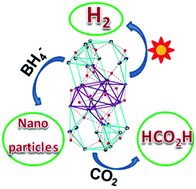Copper hydride clusters in energy storage and conversion
Abstract
Hydrogen is seen as an increasingly important clean and sustainable energy source going into the future. There are a host of materials being investigated for the storage of hydrogen. In this frontier, we provide an overview of hydride clusters derived from Earth-abundant copper being used for the storage and conversion of hydrides into hydrogen, and the reaction of CO2 with hydride sources to produce the formic acid/formate pairing, which are considered excellent hydrogen carriers. We summarize the main synthesis methods to stabilize high-nuclearity hydride clusters with phosphine, N-heterocyclic carbene, and in particular phosphor-1,1-dithiolate ligands. Unprecedented structures and hydride geometries have been revealed through both X-ray and neutron single crystal analyses. We point to the release of hydrogen in such hydride clusters through solar irradiation, thermolysis and acid treatments. Finally, we show the facile formation of rhombic nanoparticle copper morphologies derived from accurately determined high-nuclearity clusters and suggest that this could provide a mechanism that links molecular structures with bulk microstructures of materials.

- This article is part of the themed collections: Inorganic chemistry approaches to saving critical elements: Replacement and 2019 Frontier and Perspective articles


 Please wait while we load your content...
Please wait while we load your content...